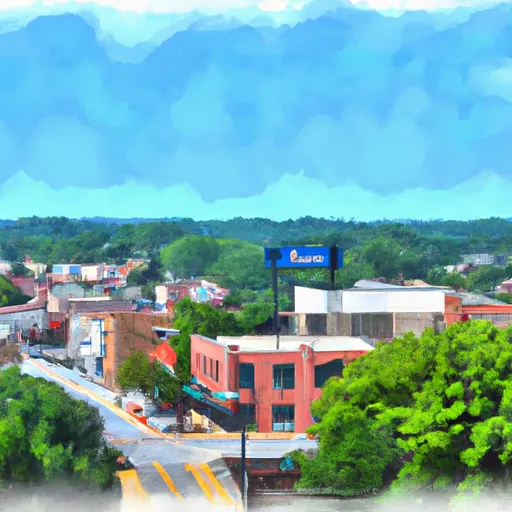-
 Snoflo Premium
Snoflo Premium
Get unlimited access to all our content
With no Ad interruptions! - Start Your Free Trial Login with existing account
Zebulon
Eden Index
Climate
8.0
•
Recreation
3.5
•
Community
2.4
•
Safeguard
5.0/10

Zebulon, Georgia is a small town located in Pike County, in the central part of the state. The town experiences a humid subtropical climate, characterized by hot and humid summers and mild winters. Summers in Zebulon are typically hot, with temperatures ranging from the mid-80s to mid-90s Fahrenheit, while winters are mild, with temperatures averaging around the mid-50s.
In terms of hydrology constituents, Zebulon is surrounded by several water bodies, including the Flint River and several smaller creeks. These waterways provide opportunities for fishing, kayaking, and canoeing. The region’s hydrology also supports diverse wildlife, making it an ideal spot for bird watching and wildlife observation.
Outdoor recreation enthusiasts will find plenty of opportunities in Zebulon. The area has several parks and nature reserves, such as the Pike County Park and the Okefenokee National Wildlife Refuge, offering hiking trails, camping facilities, and picnic areas. Additionally, Zebulon is located near the Piedmont National Wildlife Refuge, which boasts over 35,000 acres of forested land, perfect for hunting, fishing, and wildlife photography.
In conclusion, Zebulon, Georgia offers a pleasant humid subtropical climate, surrounded by water bodies, and providing various outdoor recreation opportunities for nature lovers.
What is the Eden Index?
The Snoflo Eden Index serves as a comprehensive rating system for regions, evaluating their desirability through a holistic assessment of climate health, outdoor recreation opportunities, and natural disaster risk, acknowledging the profound impact of these factors on livability and well-being.
Climate Health Indicator (CHI): 8.0
Zebulon receives approximately
1236mm of rain per year,
with humidity levels near 86%
and air temperatures averaging around
17°C.
Zebulon has a plant hardyness factor of
8, meaning
plants and agriculture in this region tend to thrive here all year round.
By considering the ideal temperature range, reliable water supplies, clean air, and stable seasonal rain or snowpacks, the Climate Health Indicator (CHI) underscores the significance of a healthy climate as the foundation for quality living.
A healthy climate is paramount for ensuring a high quality of life and livability in a region, fostering both physical well-being and environmental harmony. This can be characterized by ideal temperatures, reliable access to water supplies, clean air, and consistent seasonal rain or snowpacks.
Weather Forecast
Streamflow Conditions
Apalachicola
Area Rivers
Apalachicola
Snowpack Depths
Apalachicola
Reservoir Storage Capacity
Apalachicola
Groundwater Levels
Recreational Opportunity Index (ROI): 3.5
The Recreational Opportunity Index (ROI) recognizes the value of outdoor recreational options, such as parks, hiking trails, camping sites, and fishing spots, while acknowledging that climate plays a pivotal role in ensuring the comfort and consistency of these experiences.
Access to outdoor recreational opportunities, encompassing activities such as parks, hiking, camping, and fishing, is crucial for overall well-being, and the climate plays a pivotal role in enabling and enhancing these experiences, ensuring that individuals can engage in nature-based activities comfortably and consistently.
Camping Areas
| Campground | Campsites | Reservations | Toilets | Showers | Elevation |
|---|---|---|---|---|---|
| Parks at Chehaw | 50 | 201 ft | |||
| Stone Mountain Park Campground | 430 | 1,558 ft | |||
| Dobbins Lakeside Military | None | 1,079 ft | |||
| Amicalola Falls State Park | None | 1,779 ft | |||
| Poteete Creek | None | 1,832 ft | |||
| Jacks River Fields | 14 | 2,865 ft | |||
| Frank Gross | 9 | 2,356 ft | |||
| Morganton Point | 82 | 1,753 ft | |||
| Andersonville City Campground | 25 | 350 ft | |||
| Deep Hole | 18 | 1,993 ft |
Nearby Ski Areas
Catastrophe Safeguard Index (CSI):
The Catastrophe Safeguard Index (CSI) recognizes that natural disaster risk, encompassing floods, fires, hurricanes, and tornadoes, can drastically affect safety and the overall appeal of an area.
The level of natural disaster risk in a region significantly affects safety and the overall livability, with climate change amplifying these risks by potentially increasing the frequency and intensity of events like floods, fires, hurricanes, and tornadoes, thereby posing substantial challenges to community resilience and well-being.
Community Resilience Indicator (CRI): 2.4
The Community Resilience Indicator (CRI) recognizes that education, healthcare, and socioeconomics are crucial to the well-being of a region. The CRI acknowledges the profound impact of these elements on residents' overall quality of life. By evaluating educational resources, healthcare accessibility, and economic inclusivity, the index captures the essential aspects that contribute to a thriving community, fostering resident satisfaction, equity, and social cohesion.

